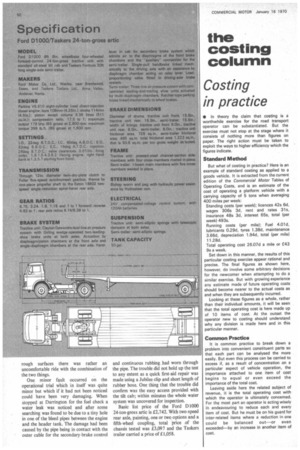the costing column Costing
Page 52

If you've noticed an error in this article please click here to report it so we can fix it.
in practice
• In theory the claim that costing is a worthwhile exercise for the road transport operator can be substantiated. But the exercise must not stop at the stage where it consists of nothing more than figures on paper. The right action must be taken to exploit the ways to higher efficiency which the figures indicate.
Standard Method
But what of costing in practice? Here is an example of standard costing as applied to a goods vehicle. It is extracted from the current edition of the Commercial Motor Tables of Operating Costs, and is an estimate of the cost of operating a platform vehicle with a carrying capacity of 5 tons when averaging 400 miles per week: Standing costs (per week); licences 42s 6d, wages 306s 3d, rent and rates 31s, insurance 48s 3d, interest 65s, total (per week) 493s.
Running costs (per mile): Fuel 4.01d, lubricants 0.29d, tyres 1.38d, maintenance 3.66d, depreciation 1.94d, total (per mile) 11.28d.
Total operating cost 26.07d a mile or £43 9s a week.
Set down in this manner, the results of this particular costing exercise appear rational and precise. The final figures as shown here, however, do involve some arbitrary decisions for the newcomer when attempting to do a similar exercise. But with growing experience any estimate made of future operating costs should become nearer to the actual costs as and when they are subsequently incurred.
Looking at these figures as a whole, rather than their individual amounts, it will be seen that the total operating cost is here made up of 10 items of cost. At the outset the operator new to costing should understand why any division is made here and in this particular manner.
Common Practice
It is common practice to break down a problem into convenient constituent parts so that each part can be analysed the more easily. But even this process can be carried to excess if, as a result of concentration on a particular aspect of vehicle operation, the importance attached to one item of cost begins to equal or even exceed the importance of the total cost.
Leaving aside here the related subject of revenue, it is the total operating cost with which the operator is ultimately concerned. For the most part an operator is acting wisely in endeavouring to reduce each and every item of cost. But he must be on his guard for inter-related items where a reduction in one could be balanced out—or even exceeded—by an increase in another item of cost.
































































































